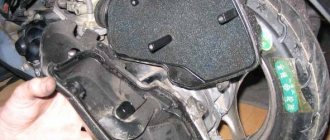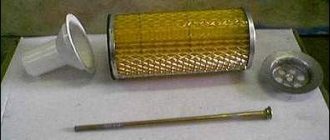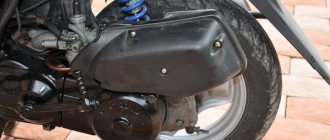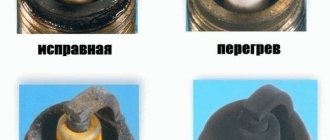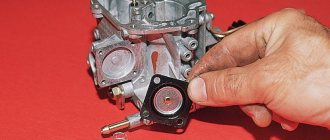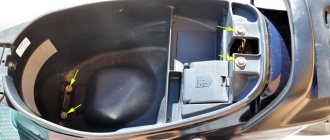In most cases, detection of fuel in the wrong place is a consequence of some other malfunction. In this case, the vehicle may stop starting altogether. The appearance of gasoline in the air filter occurs under the following circumstances:
- during the last trip I fell into a hole;
- the driver forgot to turn off the ignition at night;
- there is a loss of traction, especially at low speeds;
- a decrease in dynamic characteristics, which is especially noticeable when using 50 cc scooters, since they have no power reserve;
- gasoline flows from the carburetor drain hole, both when idle and when driving;
- drops in speed when sharply squeezing the gas handle or accelerator pedal, which is especially noticeable when driving in a traffic jam at a traffic light;
- the gas distribution unit or fuel system, for example, a carburetor, was repaired;
- the engine was running on an over-enriched mixture.
Significant mileage can also cause gasoline to get into the air filter. Physical wear of metal and gaskets leads to the creation of conditions for the occurrence of this malfunction. However, in this case, the engine will gradually start worse and worse, and the strong smell of gasoline from the air filter of a motorcycle or car will not allow the car owner to ignore the breakdown.
Carburetor petals and fuel return
When the piston moves from bottom dead center, fuel initially rushes back into the carburetor. On high-speed engines, most often used on motorcycles, a reed valve is used to prevent the air-gasoline mixture from escaping. Valves are:
- metal, characterized by low reliability;
- carbon, expensive, but rarely fail.
Garage craftsmen advise bending the valve petals if it fails. Practice shows that this is only a temporary measure and repairs with replacement of petals are not far off.
Diagnosis is performed by visual inspection. The presence of burnouts or thermal damage or twists indicates the need to purchase a new reed valve.
Despite the unexpected appearance of fuel in the air filter and the inability to start the engine, during operation you should listen to your bike, scooter, or car. Minor malfunctions in engine operation should alert the owner so that in the future he does not see the air filter pouring gasoline onto the ground.
Preventing Breakage
The sudden appearance of gasoline in the filter after visiting a gas station indicates dirty fuel. You should stop visiting unverified stations. It is also not recommended to buy fuel while replenishing the storage tank, as the flow from the fuel truck pipe lifts all the debris from the bottom of the tank.
When performing adjustment work, you should mark the positions of the mixture quality and quantity screws. To do this, you need to tighten the bolt completely, counting the revolutions. In case of subsequent unsuccessful setup, knowing the preset value, it will be much easier to return to the original state.
Driving should be as careful as possible. Any drop of the scooter may cause damage to the fuel system. Also, rust that comes off due to dynamic load can fix the locking needle, preventing it from taking the required position.
Whatever the reason for the appearance of gasoline in the filter, you should not delay troubleshooting. Operating the engine in such conditions leads to excessive wear of all parts, which increases the need for major repairs. A quick response to the first symptoms of malfunction of the fuel system will save the owner’s wallet from unnecessary waste.
If you have any questions, leave them in the comments below the article. We or our visitors will be happy to answer them
Why the carburetor on a scooter floods: finding the causes and eliminating them
Technology has one bad property - it breaks. The scooter is no exception to this rule. A common problem in operating a scooter or moped is the carburetor, a device that prepares the air-fuel mixture. This article draws attention to the following problem: why a scooter’s carburetor floods.
Causes of malfunction
You can determine that the carburetor is overflowing by several signs:
- Condition of the candle. A dirty spark plug indicates a rich fuel mixture, which means high gasoline content. Even a serviceable or new spark plug may not be able to cope with the flow of fuel entering the cylinder and over time it will become covered with soot, will be constantly wet and the engine will stop starting.
- Gasoline leaks through the air filter. Signs of fuel may be found in the air filter housing.
- Gasoline leaks through the float chamber gasket.
It is worth noting that these signs can appear either on their own or after repairs. For what reasons can the carb overflow?
Failure of the fuel valve
The tanks are equipped with vacuum fuel taps with three outlets. One of them is taking fuel from the tank, the other is supplying fuel to the carburetor. The third outlet is intended for supplying a vacuum hose. When a vacuum is created in the engine, the valve membrane begins to pump fuel.
Advice! If the engine does not start after a long period of inactivity (fuel is not pumped in), in order not to wait for the engine to pump it in, you can remove the vacuum hose on the other side of the tap and create a vacuum with your mouth until the carburetor is filled.
Clogged air filter
Air filter on a scooter
If the amount of incoming air is insufficient, the scooter can also overflow fuel.
You can diagnose the filter for air permeability as follows. Simply disconnect the air filter. If the engine now starts to work correctly, then it is necessary to change the air filter. When the carburetor on a scooter without a filter still floods, “dig deeper”!
Cleaning the foam filter
In short, let's get started.
Let's start by removing the filter. Often, in order to reach the filter, you need to unscrew the seat and part of the plastic body kit. Before removing the filter cover, you need to make sure that there are no deposits of dirt, sand or dust in the filter housing that may have entered the intake distributor during dismantling. If there is, it needs to be cleaned before removing the filter. We remove the filter and look into the air intake. It's great if you can see the carburetor directly. We are looking for dust deposits and dark deposits on the carburetor diffuser, which indicate that the air is not being cleaned well. At the next stage, after inspecting the intake tract, you should plug it with a rag (which does not leave lint and does not unravel into strings, well, it’s clean, of course) or a special lid. Since the next step in order will be cleaning the inside of the air filter housing, you need to be sure that nothing gets into the middle of the intake pipe. Why do you need to clean the air filter box? The cleaner it is, the slower the cleaned (new) filter will clog, and the box itself is also a good dust collector, especially if a crankcase exhaust is connected to it, due to which an oily deposit forms on the walls of the air filter housing. It would be advisable to clean all this with a cloth soaked in gasoline or white spirit. When working with white spirit and other solvents, it is good to use glasses, gloves and work in a well-ventilated area!
Now the fun part begins, which is actually cleaning and washing the removed foam filter.
There are a lot of specialized motorcycle chemicals for servicing filters, but a significant part of it is not approved for use in Europe due to toxicity and, accordingly, may not be officially supplied to our country. Some similar kits even come with a branded washing bucket, but considering the price products like this, I wouldn’t want to go bankrupt servicing the filter. But it needs to be serviced constantly, and no tuning bucket will reduce its dirtiness. That's why smart scooterists choose white spirit! It is prohibited to use gasoline, as there is a danger of affecting the glued seams of the air filter, and even more so, more aggressive solvents, which can directly turn foam rubber into glue, are not suitable. You need to purchase your own plastic bucket with a sealed lid and store a couple of liters of white spirit in it just for flushing purposes. This cleaning is rough and preliminary, so a couple of liters filled in is enough for repeated use.
You need to put something like a grate on the bottom of the bucket. This is so that the washed dirt particles quietly fall into the sediment and remain there without rising to the top, catching them with the filter when washing.
Troubleshooting Methods
Most often, if fuel leaks from the filter, owners rush to change the carburetor. The mistakes of this approach to repair are:
- gasoline may enter the air filter not only due to the fault of the carburetor, so replacing it with a new one may not eliminate the problem;
- ridding the float chamber of debris is not a labor-intensive process and is carried out without resorting to financial costs;
- revising the settings of the quality and quantity screws can eliminate the malfunction without dismantling the carburetor.
Therefore, to correct the problem, it is recommended to adhere to the following action plan:
- If there has been interference with the idle speed or mixture settings, check that they are set correctly;
- Check the operation of the vacuum valve. When closed, fuel should not pass through;
- Check the electronic starter enrichment. After turning it off, you need to test run the engine;
- Remove the carburetor and disassemble it;
- If no significant wear, deformation, or damage is visible, blow it out. If plaque or fallen resins are visually detected, the float chamber will need to be flushed;
- Some fuel system designs include a reed valve. It has low maintainability, especially when made of metal. If any bent is found, it is recommended to replace it with a new one.
It is necessary to change the carburetor only if it begins to throw fuel due to excessive wear. In this case, the vehicle has a solid mileage on the odometer and gasoline begins to be thrown into the air filter not unexpectedly, but gradually with increasing volume. Initially, you can only notice the smell, but over time the amount of fuel in the filter can reach 100 - 150 grams.
The most unpleasant situation is when the valve burns out and excessive pressure occurs, pushing fuel into the filter. This situation happens extremely rarely, but you shouldn’t discard it when looking for a breakdown. For diagnosis, it is enough to measure the compression. If its value is low, the engine should be repaired.
First filter
Link to filter: First filter There is also a shortened version: beep
I will start my review of the most massive and most versatile filter. Its versatility lies in the fact that the kit comes with three adapters for a hose with an internal diameter of 6 mm, 8 mm and 10 mm. The outer diameter of the adapter for a 6 mm hose is 6.3 mm, for an 8 mm hose is 8.1 mm, for a 10 mm hose is 9.5 mm. The filter housing is aluminum with a glass bulb.
The filter consists of eleven parts: two adapters, two side covers with rubber seals in each, a hollow pin in the center, a filter element, a filter element retainer with a rubber sealing ring and a glass bulb. By the way, the glass of the flask is very thick, the thickness of the glass is 2.7 mm (photo in the spoiler just below). In the next photo you can see all this. You can’t see all of them in the photographs, but there are 4 holes in the tube, two on one side and two on the other, it may seem that the tube is hollow and gasoline simply flows through, without filtration, but in the center the tube
Since the filter is completely disassembled, the pin must be oriented correctly when assembling it. Otherwise, the filter turns into a plug. In order to better imagine the quality of the materials, I will provide photographs of some parts of the filter. And I'll start with the filter element.
The length of the filter with installed adapters is 122.7 mm, and the weight is 49.2 g.
Other sizes
Vacuum valve does not hold
The reason why gasoline ends up outside its main path may lie in the vacuum valve. An electronic valve prevents gravity flow and excessive gasoline pressure.
To diagnose the malfunction, it is necessary to disconnect the valve from the main network and power it directly from the battery.
IMPORTANT: The valve must first be checked with a multimeter or meter for short circuits. Otherwise, the battery may be damaged and electrical injury may occur.
Chinese scooters are equipped with non-repairable vacuum valves. Repair is carried out by replacing the failed component with a new one. More serious devices use a split housing. In this case, repairs may be limited to a visual inspection of the diaphragm with a decision to replace it.
